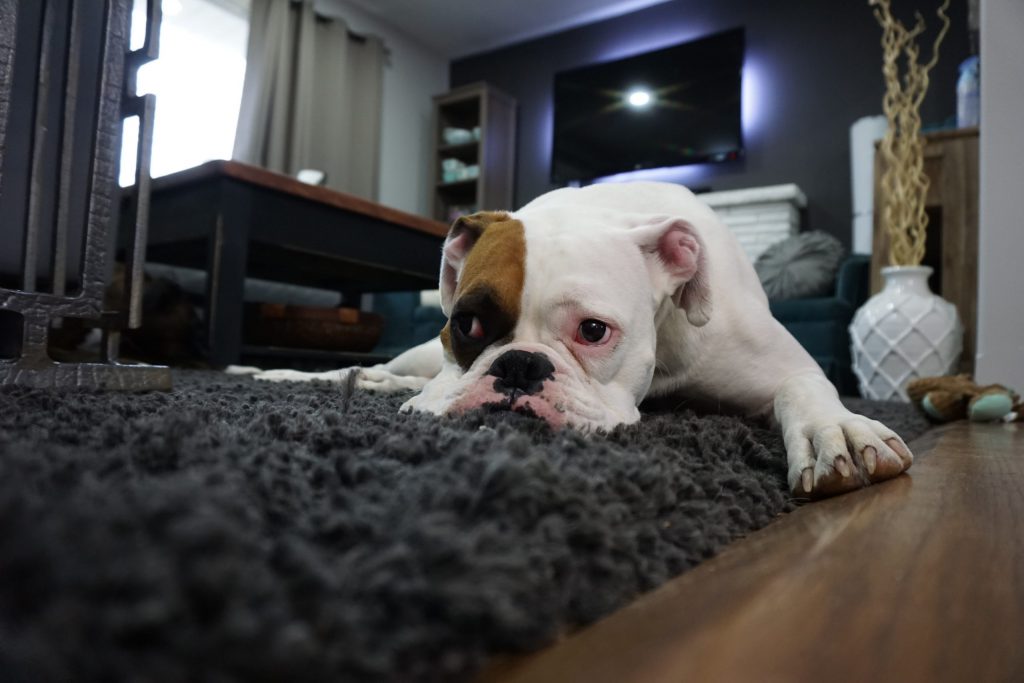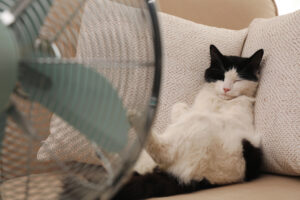In the same way that it’s common for us as humans to have allergic reactions to things both inside and outside of our home, our pets can have an allergic reaction to these same things! There are a number of potential allergens lurking throughout your home, so if you’ve noticed that something seems to be triggering your pet’s allergies, you may want to consider these sources.
Possible Allergens
Dust Mites
 Dust mites are microscopic creatures that are commonly found anywhere in your home that dust and dander tend to gather. They feed off dander, so making sure it isn’t allowed to collect anywhere will go a long way in minimizing the allergens in your home and reducing your pet’s allergies.
Dust mites are microscopic creatures that are commonly found anywhere in your home that dust and dander tend to gather. They feed off dander, so making sure it isn’t allowed to collect anywhere will go a long way in minimizing the allergens in your home and reducing your pet’s allergies.
Some areas where dust mites are frequently found include bedding, mattresses, blankets, and couches. These are areas where dander and dust usually accumulate, making them popular for dust mites, and highly likely to trigger your pet’s allergies.
Because dust mites are so common, they are one of the most common allergens that pets are susceptible to. An allergic reaction caused by dust mites will usually be visible on your pet’s skin. It may become itchy, red, inflamed, and your pet may eventually suffer from dermatitis. If you see these signs, dust mites are likely causing your pet’s allergies to flare up.
Frequently cleaning blankets, couches, mattresses, and changing bedding material is important in reducing the presence of these creatures.
Remember, dust mites don’t just gather in human bedding. Your pet sheds plenty of dander as well, so you’ll need to clean or change their bedding as well to prevent allergies.
Dander
 While stray dander is an issue that can create a home for dust mites, dander itself can cause allergies as well.
While stray dander is an issue that can create a home for dust mites, dander itself can cause allergies as well.
Dander is material that is naturally shed from the bodies of humans and animals that have hair, fur, or feathers. Shedding is part of skin replacement and is important for keeping skin healthy.
Unfortunately, dander can spark your pet’s allergies by causing irritation when it comes in contact with their skin or is inhaled into their airways.
To prevent the build-up of irritating dander, you’ll want to take the same steps that you would in preventing dust mites. Frequently dusting, vacuuming, bathing, and cleaning bedding will minimize the amount of dander found in your home.
Bedding
 While your pet’s allergies are more likely to be caused by a build-up of dust mites and dander in their bedding, the specific material that your pet’s bedding is made of may trigger an allergic reaction as well
While your pet’s allergies are more likely to be caused by a build-up of dust mites and dander in their bedding, the specific material that your pet’s bedding is made of may trigger an allergic reaction as well
Beds made using wool, down, or feather-based materials are most likely to aggravate allergies, while cotton material is least likely to cause allergies.
However, even if your pet’s bed is hypoallergenic, regularly cleaning pet bedding is important, as dust mites and dander can still build up and cause an allergic reaction. In addition to this, your pet’s allergies may also be caused by residual detergent, fabric softener, or even chemicals used in the production of the bedding.
Other Pets
 Your pet’s allergies may even be caused by new animals introduced into your home. If you’ve recently brought home a new pet and noticed that another pet seems to be having an allergy flare-up, this could be the cause.
Your pet’s allergies may even be caused by new animals introduced into your home. If you’ve recently brought home a new pet and noticed that another pet seems to be having an allergy flare-up, this could be the cause.
In addition to this, allergies to dander can develop at any time in your pet’s life, so while they may not have been allergic to another pet in the past, they may develop an allergy to their dander over time.
This is an uncommon cause of allergies, but if there seem to be no other possible causes, you may want to consider this.
Chemical Irritants
Chemicals are a common irritant that can cause allergic reactions in both humans and animals, and there a number of chemicals that this irritation can come from.
 Household cleaners, shampoo, detergent, soap, hairspray, pool water, and aerosol cleaners are all examples of potential chemical irritants that can provoke your pet’s allergies.
Household cleaners, shampoo, detergent, soap, hairspray, pool water, and aerosol cleaners are all examples of potential chemical irritants that can provoke your pet’s allergies.
These chemicals can cause contact dermatitis if they come in contact with your pet’s skin, so you may want to consider switching to all-natural, fragrance-free, and dye-free cleaning products. You may also want to rethink using aerosol sprays when cleaning your home, as these sprays can land on your pet’s bedding or other surfaces your pet frequently comes into contact with and may cause irritation.
In addition to this, if your pet loves to swim, you’ll want to make sure they get a bath once they’re out of the pool because the chlorine in pool water can cause contact dermatitis as well.
Mold
 Mold can be another cause of irritation that may not be visible because it thrives in dark spaces. Any space that is regularly exposed to moisture will be likely to grow mold. These include bathrooms, basements, crawl spaces, laundry rooms, mudrooms, and kitchens, especially if you live in a region that is naturally very humid.
Mold can be another cause of irritation that may not be visible because it thrives in dark spaces. Any space that is regularly exposed to moisture will be likely to grow mold. These include bathrooms, basements, crawl spaces, laundry rooms, mudrooms, and kitchens, especially if you live in a region that is naturally very humid.
In order to combat this, you should ventilate these rooms as well as possible, or you may even want to purchase a dehumidifier to soak up to moisture in these rooms. Wiping up spills will also help prevent mold growth.
If you believe that mold is growing in your home and causing your pet’s allergies, it’s best to call a professional to assess the situation.
Indoor Plants
 The plants inside your home can cause allergies for a variety of reasons. The potting soil that your plants live in can begin to grow mold if overwatered, exacerbating allergies, which is why it’s important to keep plants in a well-lit and ventilated room. If you have flowering plants in your home, they may release pollen which will aggravate your pet’s allergies as well.
The plants inside your home can cause allergies for a variety of reasons. The potting soil that your plants live in can begin to grow mold if overwatered, exacerbating allergies, which is why it’s important to keep plants in a well-lit and ventilated room. If you have flowering plants in your home, they may release pollen which will aggravate your pet’s allergies as well.
Pollen and mold can cause irritation when it comes in contact with your pet’s skin, or if it is inhaled. Because of this, symptoms will typically show up as itchy skin, excessive grooming, rashes, sneezing, and eye discharge.
However, it’s important to remember that although plants inside your home can cause allergies, plants outside of your home can cause allergies as well. Pollen can be brought into your home when it lands on your clothing, shoes, your pet’s hair, or even when your windows are open so you can feel the breeze.
Installing a HEPA filter or having an air purifier in your home will help reduce the amount of pollen circulating.
Smoking/Vaping
Pets can be sensitive to smoke of any kind, whether it’s from cigarettes,

cigars, vaping, or even cooking because smoke is a respiratory irritant. Cats and birds are known to be especially sensitive to smoke.
However, pets that live in a home with one or more companions who smoke are more likely to develop atopic dermatitis, which causes itchy skin, reactive airway disease, and environmental allergies.
Common symptoms of allergies caused by smoking may show up as shortness of breath, watery eyes, sneezing, and difficulty breathing.
Essential Oils
 Dogs and cats are known for having a heightened sense of smell, which makes them particularly sensitive to essential oils. When inhaled, these oils can irritate your pet’s respiratory system, especially if your pet has pre-existing respiratory issues.
Dogs and cats are known for having a heightened sense of smell, which makes them particularly sensitive to essential oils. When inhaled, these oils can irritate your pet’s respiratory system, especially if your pet has pre-existing respiratory issues.
In addition to this, some essential oils such as birch, wintergreen, peppermint, and tea tree are actually toxic. While these essential oils are most commonly known to cause harm to pets, your pet’s allergies may be triggered by other specific essential oils, so you will want to be careful when using them in your home.
Determining the Cause of Your Pet’s Allergies
As you can see from this long list of potential allergens, it can be difficult to determine what exactly may be the cause of your pet’s allergies. Of course, consulting your veterinarian will be the most helpful step to take, as they will be able to help you determine the cause and can also offer you options for moving forward, but you can also conduct an elimination trial to get to the bottom of your pet’s allergies.
In order to conduct an elimination trial, you’ll want to remove anything new that has recently been brought into your home. Once all new items have been removed, or if there are no new items in your home, you should move on to removing as many potential allergens as possible.
Once this is done, monitor your pet to see if they seem to be feeling better. After you remove all irritants, slowing add them back into your home and monitor your pet’s reaction to each item.
Reducing Allergens in Your Home
If you’d like to take a proactive approach, there are also a variety of ways to reduce the number of allergens present in your home.
Cleaning your home and your pet’s bedding often and thoroughly with all-natural, fragrance-free, dye-free cleaners and detergents will reduce dander and dust build-up, while using these specific cleaners will reduce the likelihood of your pet having an allergic reaction to the products used in the cleaning process.
Installing a HEPA filter will help take dust and pollen out of the air circulating in your home, reducing the possibility or your pet developing a respiratory issue due to these allergens.
You should also vacuum your home frequently, change furnace filters every month, disinfect frequently, and avoid using wool blankets. Placing plug-in air purifiers throughout your home will also reduce the allergens in the air.
Once again, consulting with your veterinarian about your pet’s allergies will be helpful in determining the cause and how to move forward as well.
If you are in the San Diego area and looking for quality pet care services you can rely on Fon Jon Pet Care. Contact Fon Jon Pet Care at 1-858-250-3601 or visit our site today and we will be happy to help you with your pet care service needs.





















